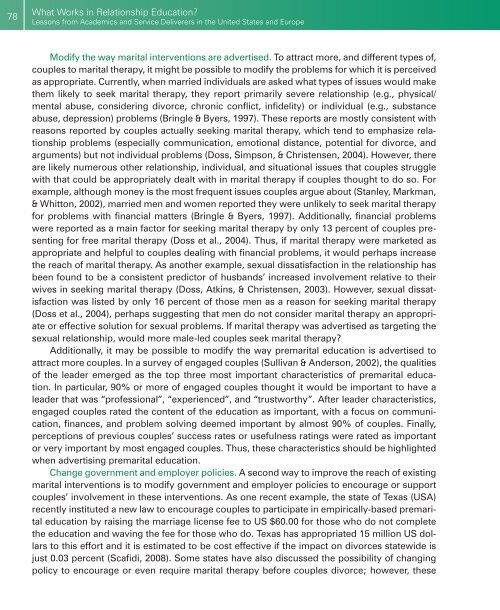Expanding the Reach and Effectiveness of Marital Interventions
Expanding the Reach and Effectiveness of Marital Interventions
Expanding the Reach and Effectiveness of Marital Interventions
Create successful ePaper yourself
Turn your PDF publications into a flip-book with our unique Google optimized e-Paper software.
78What Works in Relationship Education?Lessons from Academics <strong>and</strong> Service Deliverers in <strong>the</strong> United States <strong>and</strong> EuropeModify <strong>the</strong> way marital interventions are advertised. To attract more, <strong>and</strong> different types <strong>of</strong>,couples to marital <strong>the</strong>rapy, it might be possible to modify <strong>the</strong> problems for which it is perceivedas appropriate. Currently, when married individuals are asked what types <strong>of</strong> issues would make<strong>the</strong>m likely to seek marital <strong>the</strong>rapy, <strong>the</strong>y report primarily severe relationship (e.g., physical/mental abuse, considering divorce, chronic conflict, infidelity) or individual (e.g., substanceabuse, depression) problems (Bringle & Byers, 1997). These reports are mostly consistent withreasons reported by couples actually seeking marital <strong>the</strong>rapy, which tend to emphasize relationshipproblems (especially communication, emotional distance, potential for divorce, <strong>and</strong>arguments) but not individual problems (Doss, Simpson, & Christensen, 2004). However, <strong>the</strong>reare likely numerous o<strong>the</strong>r relationship, individual, <strong>and</strong> situational issues that couples strugglewith that could be appropriately dealt with in marital <strong>the</strong>rapy if couples thought to do so. Forexample, although money is <strong>the</strong> most frequent issues couples argue about (Stanley, Markman,& Whitton, 2002), married men <strong>and</strong> women reported <strong>the</strong>y were unlikely to seek marital <strong>the</strong>rapyfor problems with financial matters (Bringle & Byers, 1997). Additionally, financial problemswere reported as a main factor for seeking marital <strong>the</strong>rapy by only 13 percent <strong>of</strong> couples presentingfor free marital <strong>the</strong>rapy (Doss et al., 2004). Thus, if marital <strong>the</strong>rapy were marketed asappropriate <strong>and</strong> helpful to couples dealing with financial problems, it would perhaps increase<strong>the</strong> reach <strong>of</strong> marital <strong>the</strong>rapy. As ano<strong>the</strong>r example, sexual dissatisfaction in <strong>the</strong> relationship hasbeen found to be a consistent predictor <strong>of</strong> husb<strong>and</strong>s’ increased involvement relative to <strong>the</strong>irwives in seeking marital <strong>the</strong>rapy (Doss, Atkins, & Christensen, 2003). However, sexual dissatisfactionwas listed by only 16 percent <strong>of</strong> those men as a reason for seeking marital <strong>the</strong>rapy(Doss et al., 2004), perhaps suggesting that men do not consider marital <strong>the</strong>rapy an appropriateor effective solution for sexual problems. If marital <strong>the</strong>rapy was advertised as targeting <strong>the</strong>sexual relationship, would more male-led couples seek marital <strong>the</strong>rapy?Additionally, it may be possible to modify <strong>the</strong> way premarital education is advertised toattract more couples. In a survey <strong>of</strong> engaged couples (Sullivan & Anderson, 2002), <strong>the</strong> qualities<strong>of</strong> <strong>the</strong> leader emerged as <strong>the</strong> top three most important characteristics <strong>of</strong> premarital education.In particular, 90% or more <strong>of</strong> engaged couples thought it would be important to have aleader that was “pr<strong>of</strong>essional”, “experienced”, <strong>and</strong> “trustworthy”. After leader characteristics,engaged couples rated <strong>the</strong> content <strong>of</strong> <strong>the</strong> education as important, with a focus on communication,finances, <strong>and</strong> problem solving deemed important by almost 90% <strong>of</strong> couples. Finally,perceptions <strong>of</strong> previous couples’ success rates or usefulness ratings were rated as importantor very important by most engaged couples. Thus, <strong>the</strong>se characteristics should be highlightedwhen advertising premarital education.Change government <strong>and</strong> employer policies. A second way to improve <strong>the</strong> reach <strong>of</strong> existingmarital interventions is to modify government <strong>and</strong> employer policies to encourage or supportcouples’ involvement in <strong>the</strong>se interventions. As one recent example, <strong>the</strong> state <strong>of</strong> Texas (USA)recently instituted a new law to encourage couples to participate in empirically-based premaritaleducation by raising <strong>the</strong> marriage license fee to US $60.00 for those who do not complete<strong>the</strong> education <strong>and</strong> waving <strong>the</strong> fee for those who do. Texas has appropriated 15 million US dollarsto this effort <strong>and</strong> it is estimated to be cost effective if <strong>the</strong> impact on divorces statewide isjust 0.03 percent (Scafidi, 2008). Some states have also discussed <strong>the</strong> possibility <strong>of</strong> changingpolicy to encourage or even require marital <strong>the</strong>rapy before couples divorce; however, <strong>the</strong>se


